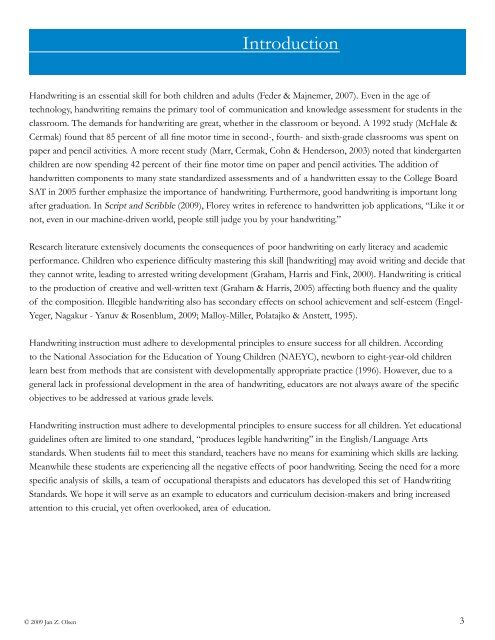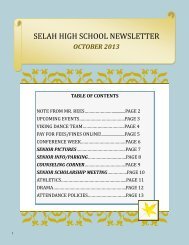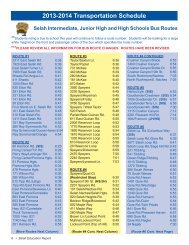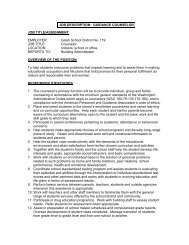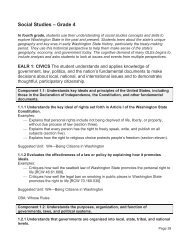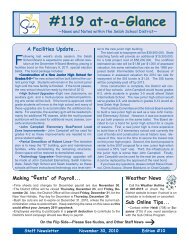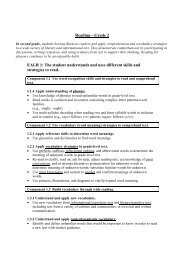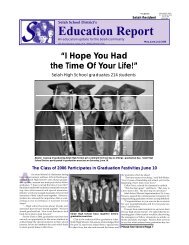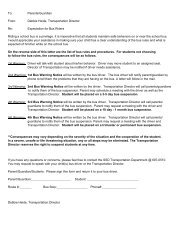Handwriting Standards - Selah School District
Handwriting Standards - Selah School District
Handwriting Standards - Selah School District
- No tags were found...
Create successful ePaper yourself
Turn your PDF publications into a flip-book with our unique Google optimized e-Paper software.
Introduction<strong>Handwriting</strong> is an essential skill for both children and adults (Feder & Majnemer, 2007). Even in the age oftechnology, handwriting remains the primary tool of communication and knowledge assessment for students in theclassroom. The demands for handwriting are great, whether in the classroom or beyond. A 1992 study (McHale &Cermak) found that 85 percent of all fine motor time in second-, fourth- and sixth-grade classrooms was spent onpaper and pencil activities. A more recent study (Marr, Cermak, Cohn & Henderson, 2003) noted that kindergartenchildren are now spending 42 percent of their fine motor time on paper and pencil activities. The addition ofhandwritten components to many state standardized assessments and of a handwritten essay to the College BoardSAT in 2005 further emphasize the importance of handwriting. Furthermore, good handwriting is important longafter graduation. In Script and Scribble (2009), Florey writes in reference to handwritten job applications, “Like it ornot, even in our machine-driven world, people still judge you by your handwriting.”Research literature extensively documents the consequences of poor handwriting on early literacy and academicperformance. Children who experience difficulty mastering this skill [handwriting] may avoid writing and decide thatthey cannot write, leading to arrested writing development (Graham, Harris and Fink, 2000). <strong>Handwriting</strong> is criticalto the production of creative and well-written text (Graham & Harris, 2005) affecting both fluency and the qualityof the composition. Illegible handwriting also has secondary effects on school achievement and self-esteem (Engel-Yeger, Nagakur - Yanuv & Rosenblum, 2009; Malloy-Miller, Polatajko & Anstett, 1995).<strong>Handwriting</strong> instruction must adhere to developmental principles to ensure success for all children. Accordingto the National Association for the Education of Young Children (NAEYC), newborn to eight-year-old childrenlearn best from methods that are consistent with developmentally appropriate practice (1996). However, due to ageneral lack in professional development in the area of handwriting, educators are not always aware of the specificobjectives to be addressed at various grade levels.<strong>Handwriting</strong> instruction must adhere to developmental principles to ensure success for all children. Yet educationalguidelines often are limited to one standard, “produces legible handwriting” in the English/Language Artsstandards. When students fail to meet this standard, teachers have no means for examining which skills are lacking.Meanwhile these students are experiencing all the negative effects of poor handwriting. Seeing the need for a morespecific analysis of skills, a team of occupational therapists and educators has developed this set of <strong>Handwriting</strong><strong>Standards</strong>. We hope it will serve as an example to educators and curriculum decision-makers and bring increasedattention to this crucial, yet often overlooked, area of education.© 2009 Jan Z. Olsen3


